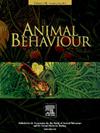南中国海北部印度洋中华白海豚发出哨声的潜在特征
IF 2.3
2区 生物学
Q2 BEHAVIORAL SCIENCES
引用次数: 0
摘要
海豚的交流涉及包括哨声在内的声学信号,其中研究较多的瓶鼻海豚会发出被称为 "签名哨声"(SW)的独特哨声。据报道,一只受伤的印度洋-太平洋座头海豚可能会发出 SW,但还没有研究试图在该物种中验证这一发现。利用在南中国海北部两个地点与自由活动的印度洋-太平洋中华白海豚相遇时收集的数据,我们对这些海豚发出的 SW 进行了调查。在分析的 3846 个哨声中,37% 通过 SIGnature 哨声识别方法被识别为潜在的 SW(PSW),并分为 82 种 PSW 类型。总体而言,在 54% 的相遇中,PSW 被识别出来。鉴于定型哨音的产生率较高(在90%的相遇中占所有哨音的62%),与已识别的PSW相比,我们认为SIGnature哨音识别方法的标准不能完全适用于检测印度洋-太平洋中华白海豚的SW,因此应开展更多的研究,使该标准适用于该物种。此外,不同地点的 PSWs 特征略有不同,这可能是由于种群的地理分隔和栖息地的差异(如噪音水平)造成的。本研究结果证实了印度洋-太平洋中华白海豚能发出包括PSW在内的定型哨音。应开展进一步研究,以确认这些哨声是否与瓶鼻海豚的SW相似。本文章由计算机程序翻译,如有差异,请以英文原文为准。
Potential signature whistle production by Indo-Pacific humpback dolphins, Sousa chinensis, in the northern South China sea
Dolphin communication involves acoustic signals, including whistles, and the well-studied bottlenose dolphins produce individually distinctive whistles called signature whistles (SWs). The production of a potential SW by an injured Indo-Pacific humpback dolphin has been reported, but no study has attempted to validate this finding in this species. Using data collected during encounters with free-ranging Indo-Pacific humpback dolphins at two locations in the northern South China Sea, we investigated the production of SWs by these dolphins. Of the 3846 analysed whistles, 37% were identified as potential SWs (PSWs) using the SIGnature whistle IDentification method and categorized into 82 PSW types. Overall, PSWs were identified during 54% of encounters. Given the high production rate of stereotyped whistles (62% of all whistles in 90% of encounters) compared with the identified PSWs, we suggest that the SIGnature whistle IDentification method criteria cannot be fully adapted for the detection of SWs in Indo-Pacific humpback dolphins, and more research should be conducted to adapt the criteria to the species. In addition, the characteristics of PSWs differed slightly between locations, potentially because of the geographical separation of populations and habitat differences (e.g. noise levels). The present results confirm the production of stereotyped whistles, including PSWs, by Indo-Pacific humpback dolphins. Further research should be conducted to confirm whether these whistles are similar to bottlenose dolphins’ SWs.
求助全文
通过发布文献求助,成功后即可免费获取论文全文。
去求助
来源期刊

Animal Behaviour
生物-动物学
CiteScore
4.60
自引率
8.00%
发文量
236
审稿时长
10.2 weeks
期刊介绍:
Growing interest in behavioural biology and the international reputation of Animal Behaviour prompted an expansion to monthly publication in 1989. Animal Behaviour continues to be the journal of choice for biologists, ethologists, psychologists, physiologists, and veterinarians with an interest in the subject.
 求助内容:
求助内容: 应助结果提醒方式:
应助结果提醒方式:


